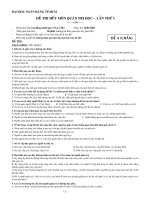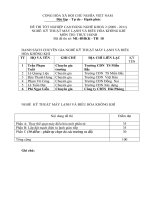PASSAGE 18
Bạn đang xem bản rút gọn của tài liệu. Xem và tải ngay bản đầy đủ của tài liệu tại đây (43.93 KB, 3 trang )
PASSAGE 18
MOBILE PHONES: Are they about to transform our lives?
We love them so much that some of us sleep with them under the pillow, yet we are increasingly
concerned that we cannot escape their electronic reach. We use them to convey our most intimate secrets,
yet we worry that they are a threat to our privacy. We rely on them more than the Internet to cope with
modern life, yet many of us don’t believe advertisements saying we need more advanced services.
Sweeping aside the doubts that many people feel about the benefits of new third generations phones and
fears over the health effects of phone masts, a recent report claims that the long-term effects of new
mobile technologies will be entirely positive so long as the public can be convinced to make use of them.
Research about users of mobile phones reveals that the mobile has already moved beyond being a mere
practical communications tool to become the backbone of modern social life, from love affairs to
friendship to work.
The close relationship between user and phone is most pronounced among teenagers, the report says,
who regard their mobiles as an expression of their identity. This is partly because mobiles are seen as
being beyond the control of parents. But the researchers suggest that another reason may be that mobiles,
especially text messaging was seen as a way of overcoming shyness. The impact of phones, however, has
been local rather than global, supporting existing friendship and networks, rather than opening users to a
new broader community. Even the language of texting in one area can be incomprehensible to anybody
from another area.
Among the most important benefits of using mobiles phones, the report claims, will be a vastly improved
mobile infrastructure, providing gains throughout the economy, and the provision of a more sophisticated
location-based services for users. The report calls on government to put more effort into the delivery of
services by mobile phone, with suggestion including public transport and traffic information and doctors’
text messages to remind patients of appointments. There are many possibilities. At a recent trade fair in
Sweden, a mobile navigation product was launched. When the user enters a destination, a route is
automatically downloaded to their mobile and presented by voiced, pictures and maps as they drive. In
future, these devices will also be able to plan around congestion and road works in real time. Third
generation phones will also allow for remote monitoring of patients by doctors. In Britain scientists are
developing an asthma management solution using mobiles to detect early signs of an attack.
Mobile phones can be used in education. A group of teachers in Britain use third generation phones to
provide fast Internet service to children who live beyond the reach of terrestrial broadband services and
can have no access to online information. ‘As the new generation of mobile technologies takes off, the
social potential of the vastly increase,’ the report argues.
Question 1. What does the writer suggest in the first paragraph about our attitudes to mobile phones?
A. We can’t live without them.
B. We are worried about using them so much.
C. We have contradictory feelings about them.
D. We need them more than anything else to deal with modern life.
Question 2. What does “them” in paragraph 2 refer to?
A. long-term effects
B. new mobile technologies
C. doubts
D. benefits
Question 3. What is the connection between social life and mobile phones?
Page 1
A. Modern social life relies significantly on the use of mobile phones
B. Mobile phones makes romantic communication easier
C. Mobile phones encourage people to make friends.
D. Mobile phones enable people to communicate while moving around
Question 4. Why do teenagers have such a close relationship with their mobile phones?
A. They use text messages more than any other group
B. They are more inclined to be late than older people
C. They feel independent when they use them
D. They tend to feel uncomfortable in many situations
Question 5. Which of the following is NOT true?
A. Mobile phone is considered as a means for the youth to show their characters.
B. Mobile phones are playing a wide range of roles in people’s life.
C. People can overcome shyness by using texting to communicating things that make them
uncomfortable.
D. There is no need to suspect the harmfulness of mobile phones.
Question 6. In what sense has the impact of phones been “local” in paragraph 3?
A. People tend to communicate with people they already know.
B. Users generally phone people who live in the same neighborhood.
C. It depends on local dialects.
D. The phone networks use different systems.
Question 7. How might mobile phones be used in the future?
A. To give the address of the nearest doctor’s surgery
B. To show bus and train timetables
C. To arrange deliveries
D. To cure diseases
Question 8. The navigation product launched in Sweden is helpful for drivers because ________.
A. it provides directions orally
B. it can suggest the best way to get to a place
C. it tells them which roads are congested
D. it shows them how to avoid road works
Question 9. What is the general attitude of the report described here?
A. Manufacturers need to produce better equipment.
B. The government should take over the mobile phone networks.
C. There are problems with mobile phones that cannot be overcome.
D. Mobile phones can have a variety of very useful applications.
Question 10. The word “pronounced” in paragraph 3 is closest in meaning to ______.
A. obvious
B. serious
C. voiced
D. overwhelmed
Page 2
ĐÁP ÁN
1-C
2-B
3-A
4-C
5-D
6-A
7-C
8-B
9-D
10-D
LỜI GIẢI CHI TIẾT
Question 1:
Trong đoạn thứ nhất, tác giả nêu ra điều gì về thái độ của chúng ta đối với điện thoại di động?
C. chúng ta có những cảm nghĩ trái ngược nhau về chúng
Question 2:
“a recent report claims that the long-term effects of new mobile technologies will be entirely positive so
long as the public can be convinced to make use of them.” => Một báo cáo gần đây nói rằng những ảnh
hưởng về mặt dài hạn của cơng nghệ điện thoại hiện mới sẽ hồn tồn tích cực nếu chúng ta có thể tận
dụng được chúng – công nghệ điện thoại mới.
Question 3:
Đoạn 3, 4, 5: cuộc sống hiện đại đang phụ thuộc rất nhiều vào điện thoại: để liên lạc, trong giao thông,
xây dựng, phát triển kinh tế, giáo dục, ...
Question 4:
Tai sao thanh thiếu niên lại gắn bó khăng khít đên như thế với điện thoại di động? C. chúng cảm thấy độc
lập khi sử dụng điện thoại di động
Question 5:
“teenagers, the report says, who regard their mobiles as an expression of their identity. .... especially text
messaging was seen as a way of overcoming shyness. => Đáp án A, B đều đúng. Đáp án C đúng (đoạn 3)
=> D. sai
Question 6:
“The impact of phones, however, has been local rather than global, supporting existing friendship and
networks” = Tác động của điện thoại, tuy nhiên, nó lại ở trong phạm vi hẹp hơn là toàn cầu khi chỉ hỗ trợ
những tình bạn hay mạng lưới đang tồn tại => điều đó có nghĩa là “loca” = mọi người thường chỉ giao
tiếp với những người họ quen biết.
Question 7:
Trong tương lai điện thoại di động có thể sẽ được sử dụng như thế nào? B. Để thông báo lịch trình của xe
buýt và tàu hỏa.
Question 8:
“At a recent trade fair in Sweden, ... . When the user enters a destination, a route is automatically
downloaded to their mobile and presented by voiced, pictures and maps as they drive” => Điện thoại chỉ
cho người lái xe biết nên đi đường nào là tốt nhất.
Question 9:
Qua các đoạn văn 3, 4, 5 chúng ta có thể thấy tác giả đề cập đến rất nhiều lợi ích của điện thoại ở những
lĩnh vực khác nhau trong hiện tại và tương lai
Question 10:
Pronounced = overwhelmed: chiếm phần đông, áp đảo, chiếm ưu thế
Page 3









